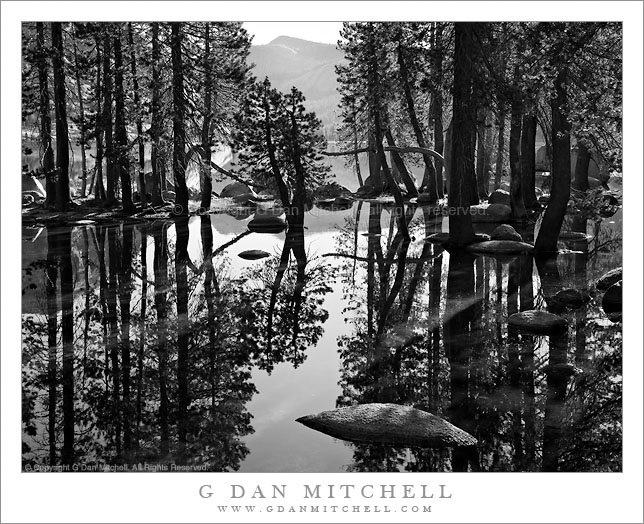Earlier this week I read Alan Ross’s fine article about the zone system and the possibility of adapting it for use with digital photography. (“Can the Zone System Go Digital“) It is a fine summary of some very important principles of exposure, and it is one of the most straightforward and readable explanations of the basics concepts of zone system exposure I’ve seen. It also offers a useful way to apply zone system principles to shooting with digital cameras.

I don’t use the zone system, but I do expose in ways that often have the same goals, especially when faced with subjects that have a very wide dynamic range (risking a loss of shadow and/or highlight detail) or, oddly, a very narrow dynamic range (where metering systems can try to turn everything neutral gray.) As I read his article I thought it might be fun to try to distill some of my basic principles for exposure down to a very short list. Here it is:
- Protect the highlights! — Overexposed highlights and bright areas can completely lose detail if they are overexposed with digital photography, and these details may not be recoverable in post.
- Watch out for dark tones that are too dark — If dark tones go too dark, they may need to be pulled back up in post, and noise, banding, and other artifacts can be the result of radical lightening of dark areas.
- Consider the most important values in the scene, and adjust exposure to favor them — You may want to compensate for the camera’s tendency to want to make black and white tones end up gray in narrow dynamic range photographs
- If important, subtle tonal variations are found in the shadows or in the highlights, consider offsetting exposure to protect them — You may want to underexpose just a bit to retain differences among tones in the bright areas. If there are a lot of important details in very dark shadows, you may wish to overexpose a bit.
- Use the danged histogram — The RGB histogram display quickly tells you a lot of important things about your exposure.
- Use the camera as the meter — Go ahead and make an exposure to test your settings. While there is a certain historical macho that says you should get it right in a single exposure, or that you should use a handheld meter, modern digital cameras can provide just as much information as external meters.
- Don’t be afraid to bracket — Sometimes it is simply faster to make several bracketed exposures rather than to figure out one “perfect” one. That may sound like a photographic blasphemy to some… but it works!
Do you have other basic exposure rules that can be applied in a general way?
 G Dan Mitchell is a California photographer and visual opportunist whose subjects include the Pacific coast, redwood forests, central California oak/grasslands, the Sierra Nevada, California deserts, urban landscapes, night photography, and more.
G Dan Mitchell is a California photographer and visual opportunist whose subjects include the Pacific coast, redwood forests, central California oak/grasslands, the Sierra Nevada, California deserts, urban landscapes, night photography, and more.
Blog | About | Flickr | Twitter | Facebook | Google+ | 500px.com | LinkedIn | Email
Text, photographs, and other media are © Copyright G Dan Mitchell (or others when indicated) and are not in the public domain and may not be used on websites, blogs, or in other media without advance permission from G Dan Mitchell.
Discover more from G Dan Mitchell Photography
Subscribe to get the latest posts sent to your email.

What are your feelings on “Expose To The Right,” Dan? I’ve been trying it more lately, and it’s certainly nice for keeping clean detail in shadows. But my feeling is that unless you’re trying to crank your ISO or are planning on really lightening up that shadow detail, it’s not worth the extra processing that it then takes to bring the highlights back down to reasonable territory.
I’m sort of a selective follower of the expose to the right mantra. I certainly want to avoid letting the overall luminosity of an image end up too far into the dark tones unless I have a good reason for doing so. And I often do like to see the brightest tones close to the right… but not past it!
Sometimes, though, I decide to not push things all the way rightward. For example, when there are a lot of subtle, near-white details that are important I will tend to not push the upper end of the histogram as much. When the brightest tones are also intensely colored — for example the golden hour highlights on clouds — I pull back a bit to avoid channel saturation and odd colored highlights.
Dan
I read it..thank you..maybe one day I will know more of it!
celia